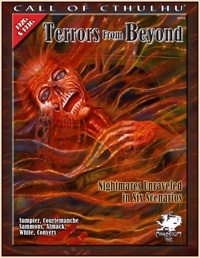
|
About OgreCave and its staff
|

|
by Andy Vetromile
Terrors from Beyond . . . well, this is Call of Cthulhu, so where else would they come from? Inside the 208-page volume are six adventures meant to make the keeper's job easier (or to facilitate tournament play). Each story has four or six pregenerated characters with built-in links to the plot so everyone starts with a vested interest in the action (and the "You all meet as students at Miskatonic University" cliché can be skipped). Since it's a series of adventures that only the keeper should read, players might want to skip from this point down to the last three paragraphs lest they spoil something for themselves.
Looking Beyond Brian Sammons' The Dig and David Conyers The Burning Stars start strong on plot but fall short at the end. The former is a good murder mystery wherein people disappear or die during a school-sponsored archaeological excavation (okay, yes, that one uses the "You all meet as students at Miskatonic University" gimmick), but it shoots itself in the foot with its expectations of the heroes. A lot is made throughout of how unfortunate the characters' chances are of surviving any given encounter, but by the climax little has changed. The investigators face the same threats (most of them now congregated) and their arsenal isn't much bigger or wider, but suddenly those tools are supposed to be sufficient here where earlier they were not. The Burning Stars, with some truly clever roleplaying challenges for the team, pits them against voodoo in Haiti. They cannot recall the last week of their lives, and worse, they keep blacking out (even more so than in your usual Cthulhu adventure). Hopefully(?) on the trail of a murderous cult, they soon find answers to their questions - answers they really didn't want to find. That gets said about every Lovecraftian story, but this time it's painfully true. While the narrative surprises in this one are innovative and fun, the ending is almost preordained, so even as these kinds of stories go this one's pretty bleak and may leave the players feeling ill-used. Death by Misadventure is the coroner's verdict in a gentleman's untimely demise, but this being a Cthulhu tale and all, the likelihood of that is pretty slim. Charles Stanhope found out some secrets about his property and its former occupants, and to make matters worse the previous owners aren't done unearthing its secrets yet, either. While author Glyn White's drawing-room murder is a compact affair, it comes with its own brand of confusion. There are a lot of keeper characters and quite a bit of geography to keep track of in its brief pages. Its use of the Mythos is a bit more blunt than some of the pieces found in this volume but not egregiously so, making this one for the twisted keepers. The setup to A Method to Madness is one we've seen or used before, yet you cannot help but admire John Almack's take on the asylum bit. The investigators have all come (or been sent) here for their own reasons, but they're united in thinking there's something fishy going on behind the scenes (other than the cute little in-jokes in the character names). Of course, they may not be able to trust their own addled senses, but patients and doctors are changing or disappearing without explanation. It's quick, it's succinct, and it's formidable, creepy adventuring. Paired with Ghost Light, these form the two most playable one-night adventures in the collection. A relief team has come to check on the inhabitants of a forlorn lighthouse, but there's no one there to greet them. There are plenty of clues, but no people. Gary Sumpter has clearly done his historical homework here so it all has a realistic feel, but he does this to the exclusion of real instructions for the keeper; the referee has to organize events and put them in motion on his own, but the story is pretty freeform anyway and it's otherwise a solid entry. It's good to see original artwork in a book - not everyone does that these days - and what we have here shows honest effort. A couple of the pieces lean a little to the caricature side, but they match the story. Too bad there aren't more of them, but Chaosium is generous with its maps, diagrams, and player aids so there's a lot of graphical decoration to break up the text. As an aside, a few handouts in the main body of the adventure are numbered out of order, and when the text claims a particular player aid is "nearby" (rather than giving a helpful, specific page number), that turns out to be an ill-defined term of no use to the keeper. Worse, they don't limit these handouts to the text of the adventures, they collect it all at the back of the book. Almost 20% of the page count is duplicate material. Having a map or letter on a page all its own would make photocopying easier, but since some pages print multiple handouts, keepers still have to clip some apart with scissors. It's really no alternative to copying the material straight from the adventure itself and snipping away anything the players shouldn't see. The pages at the back aren't perforated for easy removal, either. The other area in which Terrors from Beyond comes up short is the editing. For such literate work, it's surprising how slack the proofing is. It doesn't render it unreadable, but barely a page goes by without at least one simple oversight.
Conclusions
|
||||
 Terrors from Beyond
Terrors from Beyond